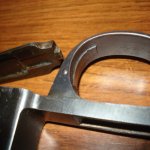I am quite sure that the marks shown in first picture Post #17 are not "proof marks" - at least as per the Swede Mausers, those would be stamps that were applied by various "Inspectors" as the piece moved from one stage to the next in production - the stamping showing that last thing done was to spec, to go ahead and do next step. Is typical that the "proof" occurred when the thing fully assembled - proofed by firing prescribed over pressure round or rounds without any measurable permanent deformity. As I understand, some arms DID NOT pass proof, but had passed all the other steps.
Regarding the cartridge - I think that one had many names - all identical thing though - 7.65 Argentine, 7.65 Mauser, 7.65 Belgian and other names. The RCBS die set here calls it "7.65x53 B M" - RCBS S/N: 14301. From the backward cursive "E"'s that I see, as if those parts from a 1908 Brazil - also a Mauser 98 variant. Contrary to post above, I have two Argentine 1909 rifles here - one is the long Infantry rifle and other is the shorter Cavalry Carbine - neither has the hinged floor plate "button" - they have a lever set into the front face of the trigger guard, to release their hinged floor plate.








































































